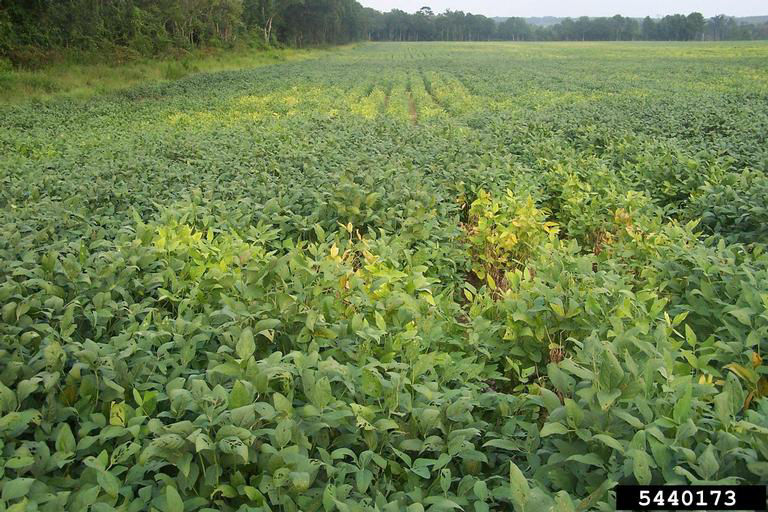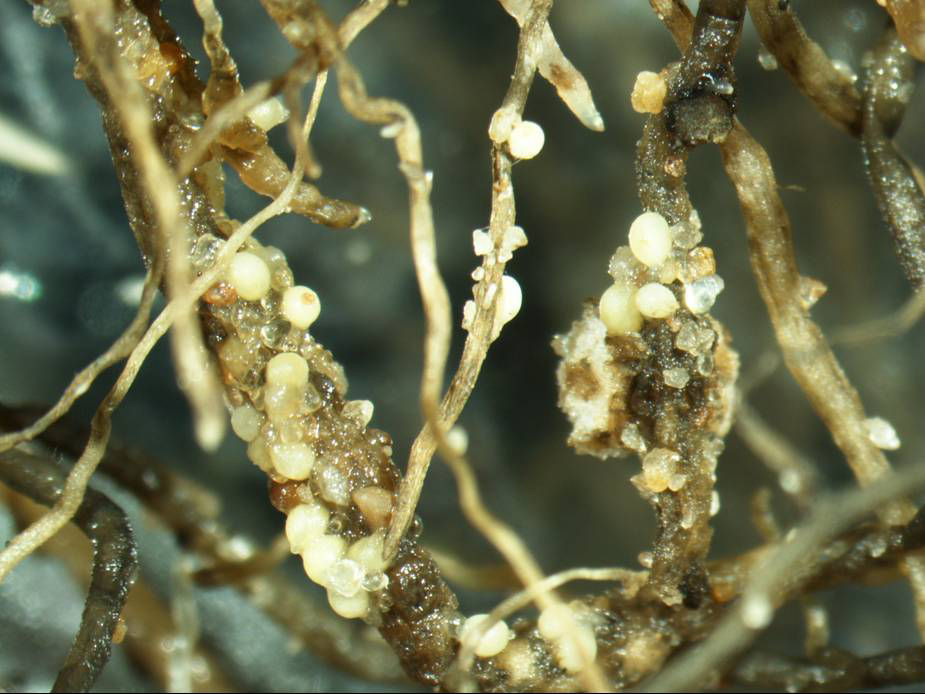Management of Parasitic Nematodes Attacking Soybean
April 30, 2025
- Nematodes are microscopic, thread-like worms that feed on plant roots, creating entry points for disease.
- The presence of nematodes can limit yield potential and often goes undetected until a field is sampled.
- Identification of nematode species is critical and management requires an integrated approach.
Biology
Plant-parasitic nematodes that feed on soybean spend their entire life in the soil. They are classified by where they live while feeding on the plant. Thus, it is critical to sample the correct component, the root or soil to determine the correct species of nematode.1
- Endoparasitic nematodes, like soybean cyst nematode (SCN) or root-knot nematodes (RKN), live within the root. To detect endoparasitic nematodes like SCN, root tissue must be included in the soil samples to provide egg and cyst counts.
- Ectoparasitic nematodes, such as lance, lesion, and reniform nematode live in the soil outside of the root and only require soil samples. The presence of nematodes may vary based on soil type, environmental conditions, and the presence or absence of actively growing host plants. Many species thrive in sandy soils, though soybean cyst nematodes can be found almost anywhere, including heavier soils. Under favorable conditions, most parasitic nematodes can complete their lifecycle (egg, four juvenile stages, egg-producing adult) in about one month, and may complete four or more lifecycles in one growing season.1 Mature females of some species, such as SCN, can produce hundreds of eggs, quickly leading to high population densities.
Damage Symptoms
Significant yield loss and injury can occur in a field without any obvious above-ground symptoms. When above-ground symptoms appear, it often indicates that a long-term problem has been occuring.1 Environmental stresses, such as drought, can accentuate the effects of nematode damage. Infected soybean plants have poorly developed root systems, reducing the plant’s ability to efficiently uptake water and nutrients. Stunting, yellowing, early death, and low yields are common symptoms of nematode injury in soybean (Figure 1). These symptoms may be hard to distinguish from other stresses like nutrient deficiency, soil compaction, or chemical injury; therefore, fields should be sampled to confirm the presence of nematodes. Root injury symptoms include a dark-coloring, poorly developed root systems and reduced nodule formation. Openings on plant roots created by nematodes can serve as an entry-point for other pathogens, like those that cause brown stem rot and sudden death syndrome. Some species, like RKN and SCN, have distinct symptoms on soybean roots which can aid in diagnosis. Plants with nematode damage symptoms are often found in irregular or oval shaped patches, and not across a whole field. Symptoms are likely to first occur near field entrances, compacted headlands, flooded areas, knolls, and fence rows.

Species
Soybean is a host to many plant-parasitic nematodes. Soybean cyst nematode is the primary nematode pest of soybean; however, because of the importance of SCN, other nematodes that attack soybean are often overlooked. Other pathogenic nematodes that infect soybean include root-knot, reniform, lesion, lance, sting, stunt, and pin nematodes.
Soybean Cyst Nematode (SCN)
The soybean cyst nematode is generally considered the most important pest of soybean in the United States and Canada. Attracted by a chemical release from the soybean, the SCN juveniles move short distances through the soil to penetrate soybean roots and establish a feeding site within the vascular tissue.1 Adult females remain sedentary within the roots and take on a lemon-shape as they grow and swell. When fully developed, the female’s body will break through the root surface, becoming visible from the outside of the root, yet remain attached to the feeding site. The female can produce hundreds of eggs, some of which are deposited on the outside of their body as the eggs hatch, they will begin a new lifecycle resulting in new infections. Not all the eggs produced by the female will hatch in the same year and some will remain in the female’s body. SCN females are initially white in color, turn yellow as they mature and brown after they die. This is the cyst, which serves as the overwintering structure for the eggs. In some areas, SCN infection may induce iron-deficiency chlorosis (IDC).7 Adult females that are engorged with eggs and have broken through the root can be observed with the naked eye on soybean roots during the growing season. Plants must be carefully dug from the soil (not pulled up) and the soil removed to expose the lemon shaped nematodes (about 1/32 inch or 1 mm diameter) (Figure 2).

Root-knot Nematodes (RKN)
There are several different species of root-knot nematodes, the southern root-knot and northern root-knot nematodes are the most common, and largely confined to sandy soils. In general, the southern root-knot nematode is more damaging than the northern root-knot nematode. Injury symptoms include extremely stunted plants early in the season or early death during bloom and pod fill. Injury can be more serious in drought conditions. Root galls are a distinctive feature of this nematode and make it easy to identify. RKN damage is usually associated with spots or areas within a field and rarely occurs across the entire field.5,6
Reniform Nematode
The reniform nematode is found in southern states and gets its name because the swollen adult female is kidney, or "reniform" shaped. It is more prevalent in silty soils and is almost never found in the same fields with root-knot nematode. Reniform nematodes have a short lifecycle, 18 to 20 days, and can have many generations within one growing season.
Corn is moderately tolerant to reniform nematode and can be used in rotation to help reduce the economic impact of nematode injury.
Lesion Nematodes
Lesion nematodes are small, migratory endoparasites. Although not a serious pest of soybean, they are a concern because they feed on a wide variety of plants. Lesion nematodes are not typically found in the same field as SCN, and their numbers may increase in the absence of SCN.5 Lesion nematodes cause lesions on roots and may be similar in appearance to a fungal root rot disease.
Lance Nematodes
Lance nematodes are relatively large and confined to sandy soils with large pore spaces. They can be found throughout soybean growing regions within the U.S. and are a major soybean pest in southern states. Lance nematodes have a wide host range; therefore, rotation is not an effective control method.
Sting, Stunt, and Pin Nematodes
These three nematodes are not considered major pests of soybeans; however, sting nematodes, can be extremely damaging. All three are ectoparasites and largely confined to sandy soils. On non-sandy soils they are rarely of economic importance.
Sampling and Management
Soil sampling is recommended to confirm the presence of nematodes in a field. Ideally, sampling should be done in the fall after harvest but can be done at any time during the year as the soil permits. Soil cores should be taken from the top 6 to 8-inches of soil, intersecting the root zone, and 10 to 20 cores per 20-acre area should be collected. Because nematodes are generally not evenly distributed within a field, several composite samples should be taken. Samples from high risk or suspected areas should be included, such as near a field entrance, areas with flooding history, and low-yielding areas of a field. Once nematodes are identified in a field, management practices should be used to help minimize economic injury and keep population densities as low as possible. Because there are many nematode species, identification is essential for determining the appropriate management option. For certain nematode populations, the recommended management practice is crop rotation. Soybean management practices that reduce crop stress may help the crop overcome nematode attacks.
Table 1. Action thresholds for soybean nematodes.

The following agronomic practices may help farmers manage potential nematode infestations.
- Fertility: Plants suffering from nutrient deficiency are more susceptible to injury.
- Weed Control: Weeds are hosts for many nematodes; reducing weeds can help keep nematode populations low.
- Crop Rotation: For certain nematode species, rotating to a non-host crop can keep population densities low.
- Chemical Control: Nematicides and seed treatments may be an effective control measure against soybean nematodes.
- Nematode tolerant products: Soybean products with nematode tolerance can be an effective management strategy against certain nematodes, particularly SCN. There are different types of tolerant soybean varieties, so rotation among varieties with different resistance genes is a recommended practice. Nematode ratings for soybean seed products are available in the Bayer Seed Catalog.
- Available from Bayer, is a nematicide seed treatment, ILEVO® Seed Treatment (fluopyram) as part of Acceleron® Seed Applied Solutions offering. ILEVO® Seed Treatment is a broad spectrum nematicide and labeled for protection against lance, reniform (Rotylenchulus reniformis), root lesion, southern root-knot (Meloidogyne incognita), and SCN.
Nematode management requires an integrated approach and is an ongoing process. Sampling and identification of the nematodes present is crucial to creating an effective management strategy to help protect against soybean nematodes.
Sources
1 Nelson, B., and Bradley, C. 2003. Soybean cyst nematode. North Dakota State University. www.ndsu.edu.
2 Overstreet, C., and Xavier-Mis, D. 2016. Nematodes on soybean. LSU Ag Center. www.lsuagcenter.com.
3 Soybean cyst nematode. Iowa State University. http://crops.extension.iastate.edu
4 Tylka, G. 2013. Sample fields for soybean cyst nematode. Iowa State University. http://crops.extension.iastate.edu.
5 Warner, F. 2006. Nematodes attacking soybeans. Michigan State University Extension. http://msue.anr.msu.edu.
6 Westphal, A. and Xing, L. Diseases of Soybean. Root knot nematode. BP-130-W. Purdue University. https://edustore.purdue.edu/bp-130-w.html.
7 Chen, S. 2012. Soybean cyst nematode management guide. University of Minnesota Extension. www.extension.umn.edu.
Jagdale, G. and Brewer, C. 2013. Guide for interpreting nematode assay results. University of Georgia Extension. https://extension.uga.edu/publications.
1311_117692